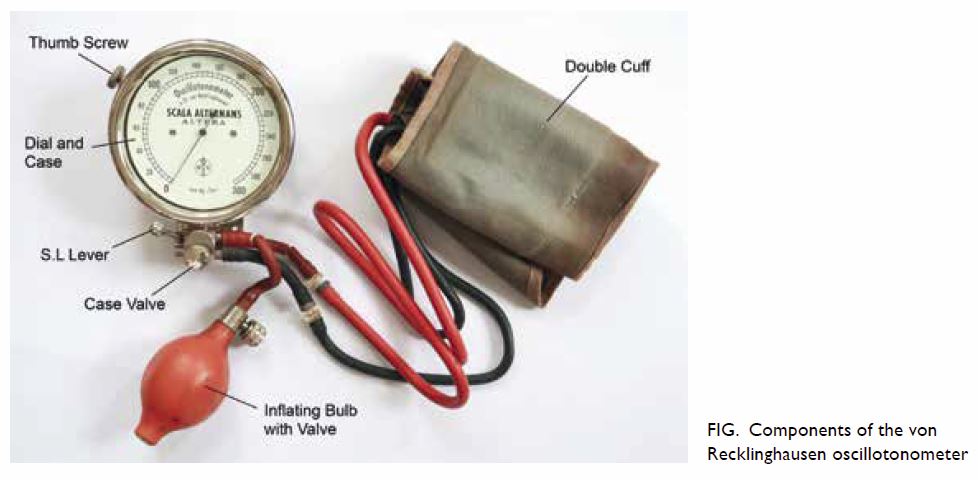Hong Kong Academy of Medicine. CC BY-NC-ND 4.0
REMINISCENCE: ARTEFACTS FROM THE HONG KONG MUSEUM OF
MEDICAL SCIENCES
von Recklinghausen oscillotonometer
TW Wong, FHKAM (Emergency Medicine)
Member of the Education and Research Committee, Hong Kong Museum of Medical Sciences Society
Stephen Hales is known as the first person to directly
measure the blood pressure in a horse, in the 18th
century. It was not until the next century when the
sphygmograph was invented to record the blood
pressure indirectly.1 Blood pressure was determined
by noting the weight required to obliterate the
radial pulse. In the 1880s, von Basch introduced his
sphygmomanometer, which recorded the pressure
need to obliterate the radial pulse using a device
similar to the aneroid barometer. In 1897, Hill and
Barnard reported in the British Medical Journal
their version of sphygmomanometer using an arm
cuff and a tambour as pressure gauge.2 Riva-Rocci in
Italy also introduced a rubber arm cuff in 1896 to
occlude the brachial artery and he used a mercury
manometer to measure the pressure. Riva-Rocci’s
mercury sphygmomanometer was introduced in
the United States by Harvey Cushing, a renowned
neurosurgeon. It became popular in the early 20th
century when the introduction of the Korotkov
sounds in 1905 made measuring of both systolic
and diastolic pressure more accurate.3 In contrast,
the oscillotonometer was more widely used in
continental Europe.
Heinrich von Recklinghausen (1867-1942)
popularised his oscillotonometer in the 1930s.
He was a German physician and scientist from
Wurzburg and his main contribution was on
the physiology of blood pressure measurement. His father was the renowned pathologist who
described von Recklinghausen’s neurofibromatosis.
There were two models of the von Recklinghausen
oscillotonometer, the Scala Alternans and the later
Scala Alternans Altera. The one possessed by the
Hong Kong Museum of Medical Sciences was
donated by Ruttonjee Hospital and it belonged to the
later model.
The von Recklinghausen oscillotonometer has
two overlapping cuffs, measuring 5 cm and 10 cm
respectively and can be inflated by a single inflation
bulb.4 Both cuffs are connected by rubber tubing to
a dial mounted in a hermetically sealed metal case.
The case contains two tambours, one connected
to the upper cuff and open to atmosphere and the
other to the lower sensing cuff and amplifies arterial
pulsation. The dial needle is connected indirectly to
the tambours and a thumb screw is used to adjust
the dial needle to zero (Fig). When taking a blood
pressure reading, both cuffs are inflated to above the
presumed systolic pressure using the inflation bulb.
Deflation via the release valve is activated by the
sustained leak lever. As the pressure drops slowly,
pulsation of the partially occluded artery under the
lower cuff will cause the needle in the case to oscillate.
At the point where one observes a definite increase
in the oscillation, the lever is released and the pointer
will stop and indicate the systolic pressure on the
dial. Further deflation by activation of the lever will allow a reading of the diastolic pressure when there
is a definite decrease in the oscillations.5
One of the advantages of the oscillotonometer
over the mercury sphygmomanometer is that
auscultation with a stethoscope is unnecessary. The
technique however can be inaccurate in a patient with
an irregular pulse, for example due to atrial fibrillation,
as it relies heavily on a constant pulse volume. The
von Recklinghausen oscillotonometer was not
as popular as the mercury sphygmomanometer
in Hong Kong, unlike in Europe. However, both were gradually replaced by new automatic digital
sphygmomanometers, which use electronic sensors
to detect pulsations transmitted from the artery. The
United Nations Minamata Convention on Mercury,
which was adopted to protect human health and the
environment from the adverse effects of mercury,
will come into effect in 2020. This will spell the end
of the mercury sphygmomanometer in countries
which have ratified the Convention. Public hospitals
in Hong Kong have already phased out the traditional
mercury sphygmomanometer.
References
1. Lau CP. The sphygmograph. Hong Kong Med J 2016;22:402-3.
2. Lawrence C. Physiological apparatus in the Wellcome museum. 3. Early sphygmomanometers. Med Hist 1979;23:474-
8. Crossref
3. Crenner CW. Introduction of the blood pressure cuff into U.S. medical practice: technology and skilled practice.
Ann Intern Med 1998;128:488-93. Crossref
4. Ball C, Westhorpe RN. Blood pressure monitoring—the von Recklinghausen oscillotonometer. Anaesth Intensive
Care 2009;37:161. Crossref
5. Corall IM, Strunin L. Assessment of the von Recklinghausen oscillotonometer. Anaesthesia 1975;30:59-66. Crossref


